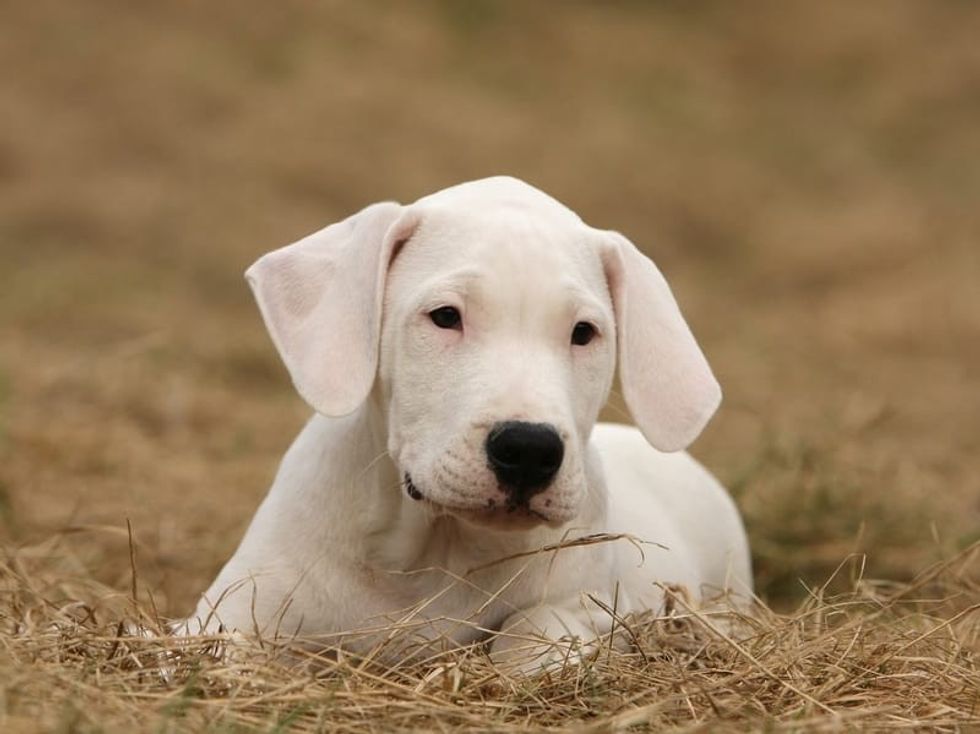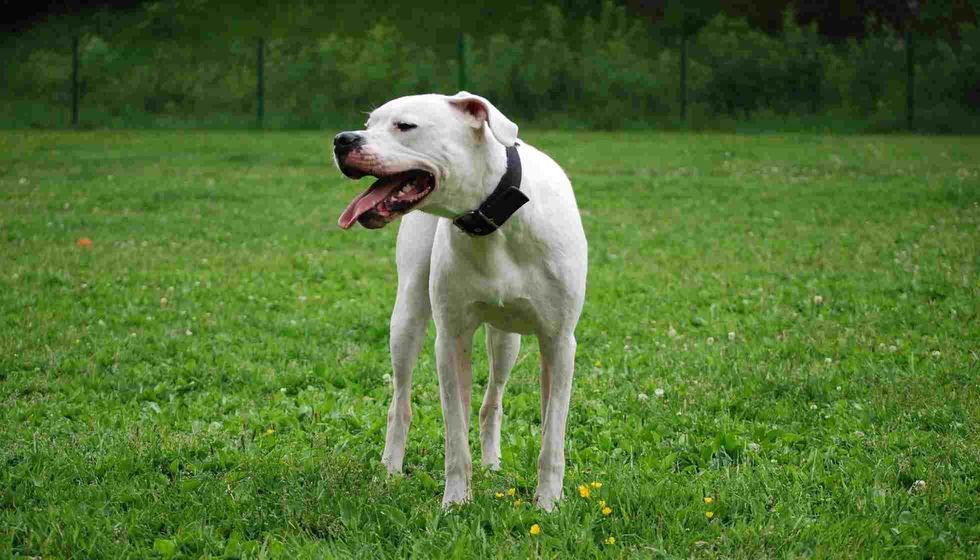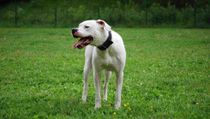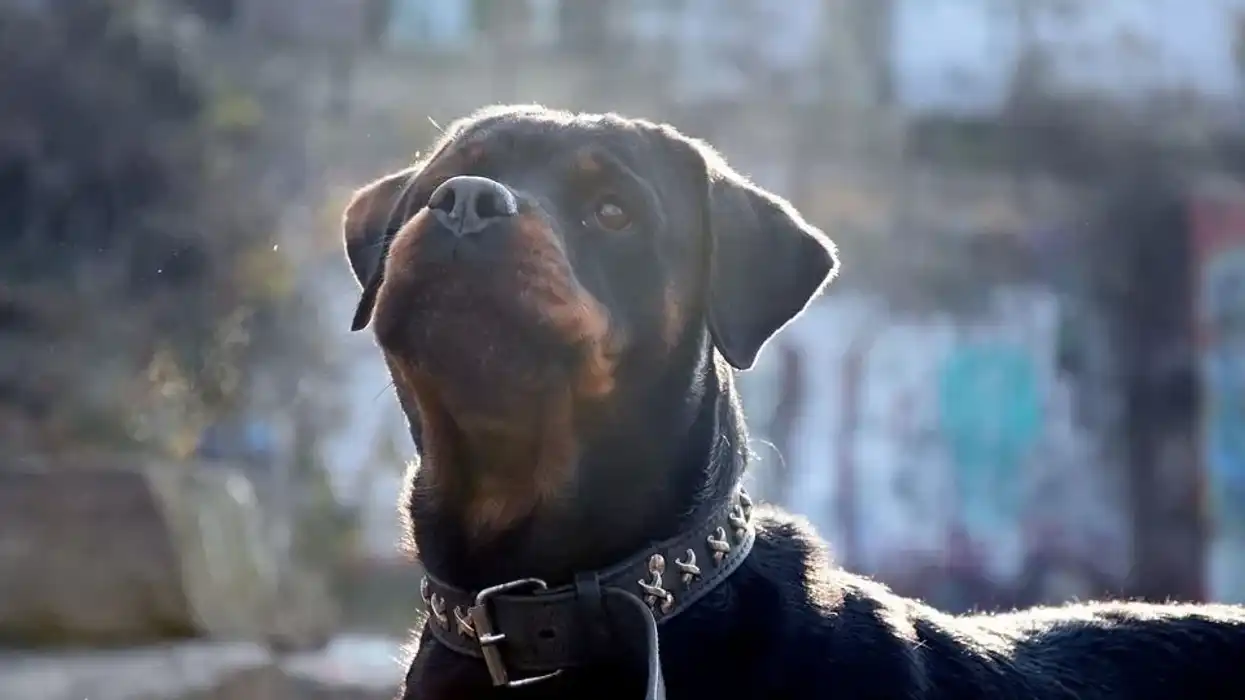Fun Dogo Argentino Facts For Kids
Content
- What type of animal is a Dogo Argentino?
- What class of animal does a Dogo Argentino belong to?
- How many Dogo Argentinos are there in the world?
- Where does a Dogo Argentino live?
- What is a Dogo Argentino's habitat?
- Who do Dogo Argentinos live with?
- How long does a Dogo Argentino live?
- How do they reproduce?
- What is their conservation status?
- What do Dogo Argentinos look like?
- How cute are they?
- How do they communicate?
- How big is a Dogo Argentino?
- How fast can a Dogo Argentino run?
- How much does a Dogo Argentino weigh?
- What are their male and female names of the species?
- What would you call a baby Dogo Argentino?
- What do they eat?
- Are they aggressive?
- Would they make a good pet?
- Did you know...
- What is a Dogo Argentino mixed with?
- What are Dogo Argentinos used for?
If you are a dog lover and looking to adopt one then you must be eager to know more about Dogo Argentino. Here you can find all that there is to know about the dog to help you to know the breed better.
Dogo Argentino is one of the larger dogs which is known to be a hunting dog. Their life expectancy stands at around 13 years.
In 1928, Dr. Antonio Nores Martinez, a medical doctor, professor, and surgeon set out to create a hybrid of different species of dogs with a now extinct mastiff-type breed called the Dog of Cordoba. This was because the latter was mostly used for hunting.
He wanted to use this hunting quality of Dog of Cordoba and make an intelligent as well as an aggressive hybrid. The result was the pure white breed, Dogo Argentino.
It was developed and bred to hunt animals such as wild boar and puma because of its strong guarding instincts. This hunting dog is very muscular with a high energy level and has a short white coat. It may also be confused with the American Pit Bull Terrier, though the Dogo Argentino is much larger in size.
The Dogo Argentino comes in a famous white coat. Sometimes Dogo Argentinos can have a pirata which is a black spot on the head.
The breed was accepted by the Federation Cynologique Internationale in 1973. In this article, you will find more information about the Dogo Argentino puppy and Dogo Argentino dog.
If you like this article about Dogo Argentino facts, you may also want to check our other animal facts articles on the Eskimo dog and Shiba Inu.
Dogo Argentino Interesting Facts
What type of animal is a Dogo Argentino?
Dogo Argentino is a type of a dog.
What class of animal does a Dogo Argentino belong to?
Dogo Argentino belongs to the class of Mammalia.
How many Dogo Argentinos are there in the world?
The Dogo Argentino is a cross-bred dog that was developed for big game hunting purposes. Although this Cordoba Fighting Dog (the ancestor of Dogo Argentino) is extinct, there are several Dogo Argentinos in the world today owing to the popularity of this dog.
Where does a Dogo Argentino live?
Dogo Argentino lives in a house and is a popular choice for a pet dog among dog lovers across the world.
What is a Dogo Argentino's habitat?
Dogo Argentino prefers plain grasslands and regions with moderate temperatures. The dog is known to live comfortably in both cold and warm or humid regions when there is moderate temperature. Extreme conditions can cause several health problems to this dog breed.
Who do Dogo Argentinos live with?
Dogo Argentino is extremely friendly and also a great watchdog. The Dogo Argentino should be socialized with other dogs from an early age for them to grow up and mingle with other dogs.
They are also great with humans and with proper training make loyal and courageous powerful pets. Dogo Argentinos do need proper attention, warmth, and love so that they get comfortable and are at their best. Rude and harsh behavior makes them aggressive.
How long does a Dogo Argentino live?
Lots of extrinsic factors like nutrition and exercise routines have an impact on the life expectancy and health of these dog breeds. They are prone to deafness. The Dogo Argentino can be prone to hypothyroidism, glaucoma, and hip dysplasia. The Dogo Argentino has a life expectancy of up to 13 years of age with proper care and medical attention.
How do they reproduce?
There are specialized breeding centers where the owners can take their dog for the purposes of mating. The Dogo Argentino bitch generally reaches puberty at eight to nine months. The gestation period is usually 55-72 days during the first mating period.
The proestrus duration is mostly variable but during this period, male attraction is high towards the female. Most Dogo Argentino females undergo normal parturition.
Dogo Argentino has a large litter size which usually consists of around 8-10 puppies. Within a few months, the puppies learn to handle themselves and become completely independent within a year. Since they are adopted, more often than not, the puppies find a loving and comforting home.
What is their conservation status?
The Dogo Argentino is not listed by the IUCN for conservation status since it is a specially bred dog. It is quite popular a breed and owning one is considered a mark of prestige in some regions.
Thus more often than not, they tend to find a home quickly at a very young age and are taken proper care of.
Dogo Argentino Fun Facts
What do Dogo Argentinos look like?
Dogo Argentino dog breed generally has a completely pure white coat all over the body, sometimes with a black spot. This breed has a very strong build as well as sturdy neck and jaws which make them look quite majestic.
They have a large mouth which makes them look dangerous and powerful. The teeth of this breed are quite sharp too.

How cute are they?
The pure flawless white coat skin makes Dogo Argentino dog breed look royal with its strong and muscular build. The breed looks powerful and is a sight you would not want to miss if you love large dogs.
The puppies of this breed are extremely cute because of their small size, white color, and high energy level although the puppy of such breeds grows up very fast into a handsome adult dog. Because of these features, dog lovers around the world will find them extremely appealing.
How do they communicate?
Dogo Argentinos were bred for the purpose of hunting and thus this breed tends to be aggressive to other animals. They bark loudly when angry or if they are not able to let off their energy or even if they get bored.
Dogo Argentinos are also dogs with a lot of self-respect and absolutely hate it when they are treated poorly. Because of their instincts, this dog gets very loud and expresses its emotions of anger, fear, and aggression through excessive barking.
Heavy breathing and palpitation are common symptoms of the dog getting excited or hungry. When properly trained and socialized from a young age, it makes the dog more friendly towards other species, including humans.
How big is a Dogo Argentino?
The adult Dogo Argentino is around 24–27 in (60–68 cm) in height and 25-30 in (65 -75 cm) length-wise. This big game dog breed comes under the category of larger dogs owing to the purpose for which they were bred.
Dietary factors and health are directly related to the proper growth and size of this dog. This bulkiness is also one of the major reasons for its popularity.
They appear powerful (and intimidating!) because of their size. Hence, they can scare off others whenever they take up a protective stance.
However, you have to make sure that the size of the dog is within the normal range. If not, then do consult a vet since irregularities in the size could result in several health hazards to the dog.
How fast can a Dogo Argentino run?
Smaller dogs, since they weigh less, tend to run faster when compared to certain larger and heavier dogs, including their parents. While the Dogo Argentino breed is quite large, still they can sprint up to speeds of 25 mph and jump around six feet high.
Their higher energy levels and the constant need to burn off the extra energy keeps them very active throughout the day.
How much does a Dogo Argentino weigh?
The weight of a dog has a lot to do with the health of the dog along with its diet and nutrition. A healthy adult Dogo Argentino's weight is around 77-99 lb (35-45 kg).
Any weight above the specified range must be looked at very carefully since obesity in dogs could create several health issues for them and so it is always important to watch your dog's weight.
What are their male and female names of the species?
The scientific name for this species is Canis but there are no individual names given to either gender of the Dogo Argentino breed. A male Dogo Argentino is called a dog while a female one is called a bitch.
What would you call a baby Dogo Argentino?
A baby Dogo Argentino is called a puppy similar to the babies of other dog breeds.
What do they eat?
Dogo Argentino is an omnivore which means it eats meat as well as vegetables. Since it is a large breed of dog, it requires proper protein-rich food to maintain its strong and sturdy build.
Dogo Argentino puppies require multiple meals each day, given in small quantities throughout the day.
It starts with four meals per day for puppies who are a few weeks old and then gradually the dog owner should reduce the number of times the meals are served but provide more sumptuous meals.
The adults require plenty of fruits, vegetables, and meat because they have high energy levels. Thus they need to eat properly in order to gain the energy lost, especially if they are engaged in a lot of exercise and other activities.
Are they aggressive?
The Doggo Argentinos carry hunting genes within them. Dogo Argentino temperament is aggressive and attacking.
They have a highly developed sense of smell and hence, they are also used in the military and bomb squad as sniffer dogs. Their aggression can be controlled if proper training is given from a young age.
Therefore, they can comfortably live in houses since they can control their temper. When they do not engage in proper exercise or activity like playtime or running activities, they are not able to burn off their extra energy.
Lack of exercise and proper working could anger them as they get restless when they have nothing to do. Harsh and rude behavior also tends to make this breed take an offensive stance.
Would they make a good pet?
Even though some countries do not allow dog owners to keep this breed as pets, they make for great pets especially for a human family that needs a powerful watchdog to protect their house from any burglary or such dangers.
The Dogo Argentino may not be a great fit as a family dog, especially if you have companion dogs.
If proper training is given from a young age then they tend to learn quickly and behave accordingly. This Argentine Dogo, just like the Argentinian Mastiff, needs a lot of attention and care in terms of medical treatments and plenty of food.
Their white coat is short and easy to maintain but the size of the Dogo Argentino makes the process of grooming a little difficult.
If you can give this Argentine Dogo the perfect dog time filled with regular walks, exercise, grooming, and playtime, then they would make good pets.
Did you know...
A Dogo Argentino puppy gets training for search and rescue, police assistance, service dogs, and guide for the blind.
Dogo Argentino likes to spend time with their family. Thanks to great stamina and fearless nature, Dogo Argentino is ready to protect their family from all kinds of threats and to fight for them until death.
Dogo Argentinos were deemed as one of the most dangerous dog breeds and banned in several countries like Denmark, Australia, and Iceland. In the United Kingdom as well it is not allowed without the proper permission and papers. It is legal in the United States and other countries with proper licenses.
Deafness is a major health concern, about 10 percent of dogs of this breed eventually get deaf in one or both ears.
What is a Dogo Argentino mixed with?
Dr. Antonio Nores Martinez was the pioneer in creating a mixed breed of a fighting dog which was also called the Cordoba dog.
This breed is unfortunately extinct today but Dogo Argentino is one of the most popular creations which continues to live and is very useful as a powerful yet intelligent dog.
The Cordoba dog was bred with different breeds like Argentinian Mastiff and Bull Terriers.
While keeping the Cordoba dog breed as the base, the Dogo dog was created by mixing the Boxer, Old English Bulldog, Great Dane, Dogue de Bordeaux, English Pointer, and Irish Wolfhound. Dr. Antonio Nores Martinez thus became successful in making a fighting and hunting dog which was very sturdy and strong in its characteristics.
What are Dogo Argentinos used for?
These dogs are extremely helpful for everything from security and police dogs to search-and-rescue and therapy dogs. They were bred for being hunting dogs.
Because of their aggression and power, they tend to be helpful in works that need those qualities. They also make for excellent watchdogs in order to protect and look after babies or look after the house.
Due to their size, it is best advised to have adult supervision when they are around small babies as they can get irritated or push little babies unknowingly. They are very friendly though and can be allowed to play with older children.
Here at Kidadl, we have carefully created lots of interesting family-friendly animal facts for everyone to discover! Learn more about some other mammals including Kunming wolfdog, or Victorian bulldog.
You can even occupy yourself at home by drawing one on our Dogo Argentino coloring pages.
We Want Your Photos!
More for You
See All
Bachelor of Arts specializing in Journalism and Mass Communication, Postgraduate Diploma in Sports Management

Moumita DuttaBachelor of Arts specializing in Journalism and Mass Communication, Postgraduate Diploma in Sports Management
A content writer and editor with a passion for sports, Moumita has honed her skills in producing compelling match reports and stories about sporting heroes. She holds a degree in Journalism and Mass Communication from the Indian Institute of Social Welfare and Business Management, Calcutta University, alongside a postgraduate diploma in Sports Management.
Disclaimer
1) Kidadl is independent and to make our service free to you the reader we are supported by advertising. We hope you love our recommendations for products and services! What we suggest is selected independently by the Kidadl team. If you purchase using the Buy Now button we may earn a small commission. This does not influence our choices. Prices are correct and items are available at the time the article was published but we cannot guarantee that on the time of reading. Please note that Kidadl is a participant in the Amazon Services LLC Associates Program, an affiliate advertising program designed to provide a means for sites to earn advertising fees by advertising and linking to Amazon. We also link to other websites, but are not responsible for their content.
2) At Kidadl, we strive to recommend the very best activities and events. We will always aim to give you accurate information at the date of publication - however, information does change, so it’s important you do your own research, double-check and make the decision that is right for your family. We recognise that not all activities and ideas are appropriate for all children and families or in all circumstances. Our recommended activities are based on age but these are a guide. We recommend that these ideas are used as inspiration, that ideas are undertaken with appropriate adult supervision, and that each adult uses their own discretion and knowledge of their children to consider the safety and suitability. Kidadl cannot accept liability for the execution of these ideas, and parental supervision is advised at all times, as safety is paramount. Anyone using the information provided by Kidadl does so at their own risk and we can not accept liability if things go wrong.
3) Because we are an educational resource, we have quotes and facts about a range of historical and modern figures. We do not endorse the actions of or rhetoric of all the people included in these collections, but we think they are important for growing minds to learn about under the guidance of parents or guardians.







